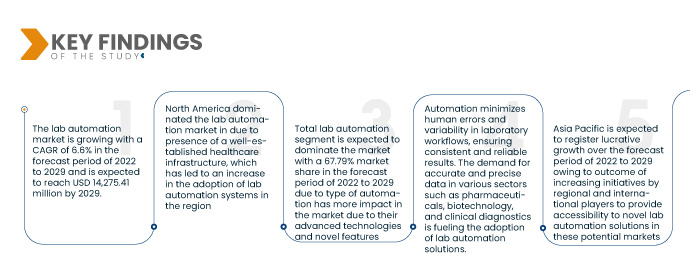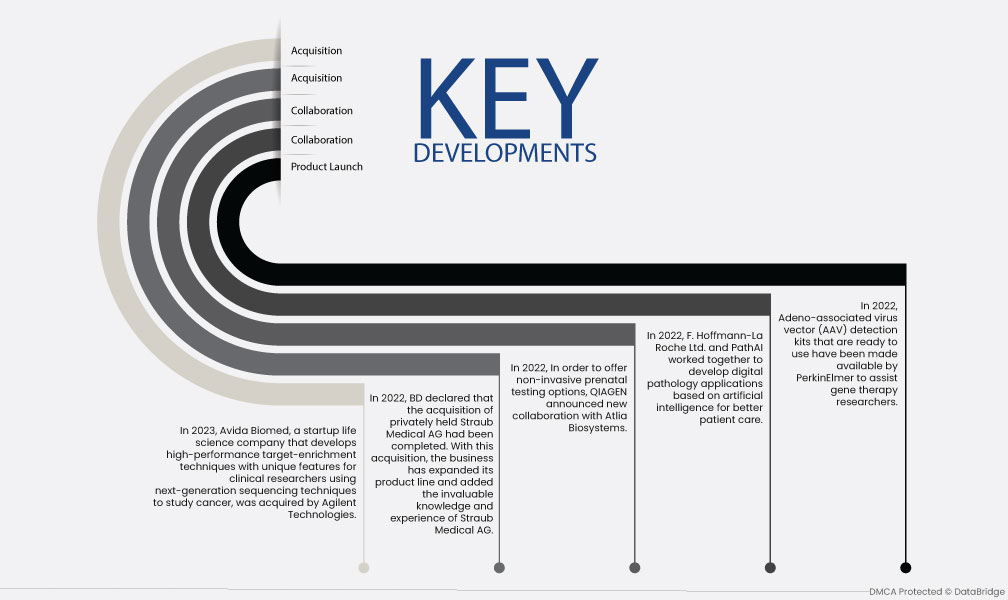La creciente demanda de atención médica a nivel mundial ha intensificado la competencia entre las principales empresas farmacéuticas y de atención médica para mejorar la automatización de los laboratorios. Esto ha llevado a una mayor utilización de equipos, analizadores y software en los laboratorios. Los actores del mercado se están centrando en ofrecer una amplia gama de herramientas, equipos, máquinas y técnicas para respaldar el desarrollo y la fabricación de infraestructura de laboratorio automatizada. Para lograrlo, las empresas están realizando importantes inversiones y obteniendo financiación para desarrollar tecnologías y métodos avanzados para la automatización de laboratorios.
Acceder al informe completo @https://www.databridgemarketresearch.com/reports/global-lab-automation-market
Data Bridge Market Research analiza que El Mercado de automatización de laboratorio está creciendo con una tasa compuesta anual del 6,6% en el período previsto de 2022 a 2029 y se espera que alcance los 14.275,41 millones de dólares para 2029. La necesidad de procesos de laboratorio más rápidos y eficientes, particularmente en el descubrimiento de fármacos y el diagnóstico clínico, está impulsando la adopción de Soluciones de automatización de laboratorio. Las capacidades de detección de alto rendimiento que ofrecen los sistemas automatizados permiten a los investigadores analizar grandes volúmenes de muestras en menos tiempo, acelerando los procesos de investigación y desarrollo.
Hallazgos clave del estudio
Se espera que los ahorros de costos y tiempo impulsen la tasa de crecimiento del mercado.
La automatización del laboratorio ofrece ahorros sustanciales de costos y tiempo al reducir el trabajo manual y optimizar los flujos de trabajo. Los sistemas automatizados manejan la preparación de muestras, el análisis de datos y la generación de informes de manera eficiente, liberando tiempo a los investigadores para tareas más valiosas. La eliminación de procesos manuales repetitivos y que consumen mucho tiempo no sólo mejora la productividad sino que también reduce el riesgo de errores humanos. Estos ahorros de costos y tiempo hacen que la automatización del laboratorio sea una solución atractiva para las industrias que buscan eficiencia, precisión y mejores resultados de investigación y desarrollo.
Alcance del informe y segmentación del mercado
|
Métrica de informe |
Detalles |
|
Período de pronóstico |
2022 a 2029 |
|
Año base |
2021 |
|
Años históricos |
2020 (Personalizable para 2014-2019) |
|
Unidades Cuantitativas |
Ingresos en millones de dólares, volúmenes en unidades, precios en dólares |
|
Segmentos cubiertos |
Tipo de producto (equipo, software, informática y analizador), tipo de automatización (automatización modular y automatización total de laboratorio), aplicación (descubrimiento de fármacos, diagnóstico clínico, soluciones genómicas, soluciones proteómicas, bioanálisis, ingeniería de proteínas, liofilización, biología de sistemas, química analítica y otros), usuarios finales (biotecnología y productos farmacéuticos, hospitales y laboratorios, instituciones académicas y de investigación y otros) |
|
Países cubiertos |
Estados Unidos, Canadá y México en Norteamérica, Alemania, Francia, Reino Unido, Países Bajos, Suiza, Bélgica, Rusia, Italia, España, Turquía, Resto de Europa en Europa, China, Japón, India, Corea del Sur, Singapur, Malasia, Australia, Tailandia, Indonesia, Filipinas, Resto de Asia-Pacífico (APAC) en Asia-Pacífico (APAC), Arabia Saudita, Emiratos Árabes Unidos, Sudáfrica, Egipto, Israel, Resto de Medio Oriente y África (MEA) como parte de Medio Oriente y África (MEA), Brasil, Argentina y Resto de Sudamérica como parte de Sudamérica. |
|
Actores del mercado cubiertos |
QIAGEN (Alemania), Siemens Healthcare (Alemania), F. Hoffmann-La Roche Ltd (Roche) (Suiza), Hamilton Company (EE.UU.), Hudson Robotics (EE.UU.),LabVantage Solutions Inc. (EE.UU.),Abbott (EE.UU.),BD (Becton, Dickinson and Company) (EE.UU.),bioMérieux (Francia), Aurora Biomed Inc. (Canadá), Danaher (EE.UU.), Tecan Trading AG - Sede: Männedorf, SuizaPerkinElmer Inc. (EE.UU.), Fisher Scientific (EE.UU.), Agilent Technologies (EE.UU.), Azenta US Inc. (EE.UU.) ),Eppendorf SE (Alemania),Labware (EE.UU.) entre otros |
|
Puntos de datos cubiertos en el informe |
Además de la información sobre escenarios de mercado como el valor de mercado, la tasa de crecimiento, la segmentación, la cobertura geográfica y los principales actores, los informes de mercado seleccionados por Data Bridge Market Research también incluyen análisis profundos de expertos, epidemiología de pacientes, análisis de tuberías, análisis de precios, y marco regulatorio. |
Análisis de segmentos:
El mercado de automatización de laboratorios está segmentado según el tipo de producto, los sistemas automatizados, la aplicación y el usuario final.
- Según el tipo de producto, el mercado mundial de automatización de laboratorio se segmenta en equipos, software e informática y analizadores. En 2022, se espera que el segmento de equipos domine el mercado con una tasa compuesta anual del 7,5% en el período previsto de 2022 a 2029 debido a que se utilizan más comúnmente, ya que actúan como elementos básicos en los laboratorios automatizados.
En 2022, se espera que el segmento de equipos domine el segmento de tipo de producto del mercado mundial de automatización de laboratorios.
En 2022, se espera que el segmento de equipos domine el mercado debido a equipos como máquinas congeladoras, máquinas cortadoras y rebanadoras, máquinas escaldadoras, máquinas clasificadoras y clasificadoras y máquinas envasadoras. Estos equipos desempeñan un papel crucial para garantizar un procesamiento eficiente y de alta calidad de mezclas de frutas y verduras congeladas con una tasa compuesta anual del 7,5% en el período previsto de 2022 a 2029.
- Sobre la base de los sistemas de automatización, el mercado mundial de automatización de laboratorios se segmenta en automatización modular y automatización total de laboratorio. Se espera que el segmento de automatización total de laboratorio domine el mercado con una participación de mercado del 67,79% en el período previsto de 2022 a 2029 debido a que el tipo de automatización tiene más impacto en el mercado debido a sus tecnologías avanzadas y características novedosas.
- Según la aplicación, el mercado mundial de automatización de laboratorios se segmenta en descubrimiento de fármacos, diagnóstico clínico, soluciones genómicas, soluciones proteómicas, bioanálisis, ingeniería de proteínas, liofilización, biología de sistemas, química analítica y otros. Se espera que el segmento de diagnóstico clínico domine el mercado con una participación de mercado del 28,83% en el período previsto de 2022 a 2029 debido a que esta categoría tiene un mayor uso de laboratorios automatizados para implementar herramientas, maquinaria y equipos avanzados para el diagnóstico.
En 2022, se espera que el segmento de diagnóstico clínico domine el segmento de aplicaciones del mercado mundial de automatización de laboratorios.
En 2022, se espera que el segmento de diagnóstico clínico domine el mercado con una participación de mercado del 28,83% debido a las muestras de control de calidad para garantizar la exactitud y precisión de las pruebas de diagnóstico. También se pueden utilizar en estudios de investigación para investigar el impacto de compuestos o nutrientes específicos en los marcadores de salud en el período previsto de 2022 a 2029.
- Según los usuarios finales, el mercado mundial de automatización de laboratorios se segmenta en biotecnología y productos farmacéuticos, hospitales y laboratorios, instituciones académicas y de investigación, y otros. En 2022, se espera que el segmento de biotecnología y productos farmacéuticos domine el mercado mundial de automatización de laboratorios con una participación de mercado del 60,73% en el período previsto de 2022 a 2029 debido al uso regular de equipos y sistemas automatizados.
Principales actores
Data Bridge Market Research reconoce que las siguientes empresas como los principales actores del mercado de automatización de laboratorio son QIAGEN (Alemania), Siemens Healthcare (Alemania), F. Hoffmann-La Roche Ltd (Roche) (Suiza), Hamilton Company (EE. UU.), Hudson Robotics (EE. UU.), LabVantage Solutions Inc. (EE. UU.), Abbott (EE. UU.), BD (Becton, Dickinson and Company) (EE. UU.), bioMérieux (Francia), Aurora Biomed Inc. (Canadá)
El desarrollo del mercado
- En 2023, Agilent Technologies adquirió Avida Biomed, una nueva empresa de ciencias biológicas que desarrolla técnicas de enriquecimiento de objetivos de alto rendimiento con características únicas para investigadores clínicos que utilizan técnicas de secuenciación de próxima generación para estudiar el cáncer.
- En 2022, BD declaró que se había completado la adquisición de la empresa privada Straub Medical AG. Con esta adquisición, la empresa ha ampliado su línea de productos y ha añadido el valioso conocimiento y experiencia de Straub Medical AG.
- En 2022, con el fin de ofrecer opciones de pruebas prenatales no invasivas, QIAGEN anunció una nueva colaboración con Atlia Biosystems.
- En 2022, F. Hoffmann-La Roche Ltd. y PathAI trabajaron juntos para desarrollar aplicaciones de patología digital basadas en inteligencia artificial para una mejor atención al paciente.
- En 2022, PerkinElmer puso a disposición kits de detección de vectores de virus adenoasociados (AAV) que están listos para usar para ayudar a los investigadores de terapia génica.
- En 2021, Becton Dickinson AG puso a disposición de los laboratorios de EE. UU. una plataforma de diagnóstico molecular de alto rendimiento totalmente automatizada.
Análisis Regional
Geográficamente, los países cubiertos en el informe del mercado de automatización de laboratorio son EE. UU., Canadá y México en América del Norte, Alemania, Francia, Reino Unido, Países Bajos, Suiza, Bélgica, Rusia, Italia, España, Turquía, resto de Europa en Europa, China, Japón. , India, Corea del Sur, Singapur, Malasia, Australia, Tailandia, Indonesia, Filipinas, Resto de Asia-Pacífico (APAC), Arabia Saudita, Emiratos Árabes Unidos, Sudáfrica, Egipto, Israel, Resto de Oriente Medio Oriente y África (MEA) como parte de Medio Oriente y África (MEA), Brasil, Argentina y Resto de Sudamérica como parte de Sudamérica.
Según el análisis de investigación de mercado de Data Bridge:
América del Norte es Se espera que domine la región en el mercado de automatización de laboratorio durante el período de previsión 2022-2029
América del Norte dominó el mercado de automatización de laboratorios y representó la mayor participación en los ingresos del 36,4% en 2020 y se espera que mantenga la posición durante el período de pronóstico. El crecimiento se atribuye a la presencia de una infraestructura sanitaria bien establecida, lo que ha llevado a un aumento en la adopción de sistemas de automatización de laboratorio en la región. Además, la presencia local de los principales actores y el marco de reembolso de apoyo en esta región también está impulsando la penetración de soluciones novedosas en el mercado.
Se estima que Asia-Pacífico es la región de más rápido crecimiento en el mercado de automatización de laboratorios para el período de previsión 2022-2029
En Asia Pacífico, se espera que el mercado muestre una CAGR exponencial del 9,9% durante el período previsto, lo que puede atribuirse a la creciente demanda de automatización de laboratorios en las economías emergentes, como China e India. También se cree que el lucrativo crecimiento registrado por esta región es el resultado de cada vez más iniciativas por parte de actores regionales e internacionales para brindar accesibilidad a novedosas soluciones de automatización de laboratorio en estos mercados potenciales.
Para obtener información más detallada sobre la automatización del laboratorio mercado informe, haga clic aquí –https://www.databridgemarketresearch.com/reports/global-lab-automation-market














